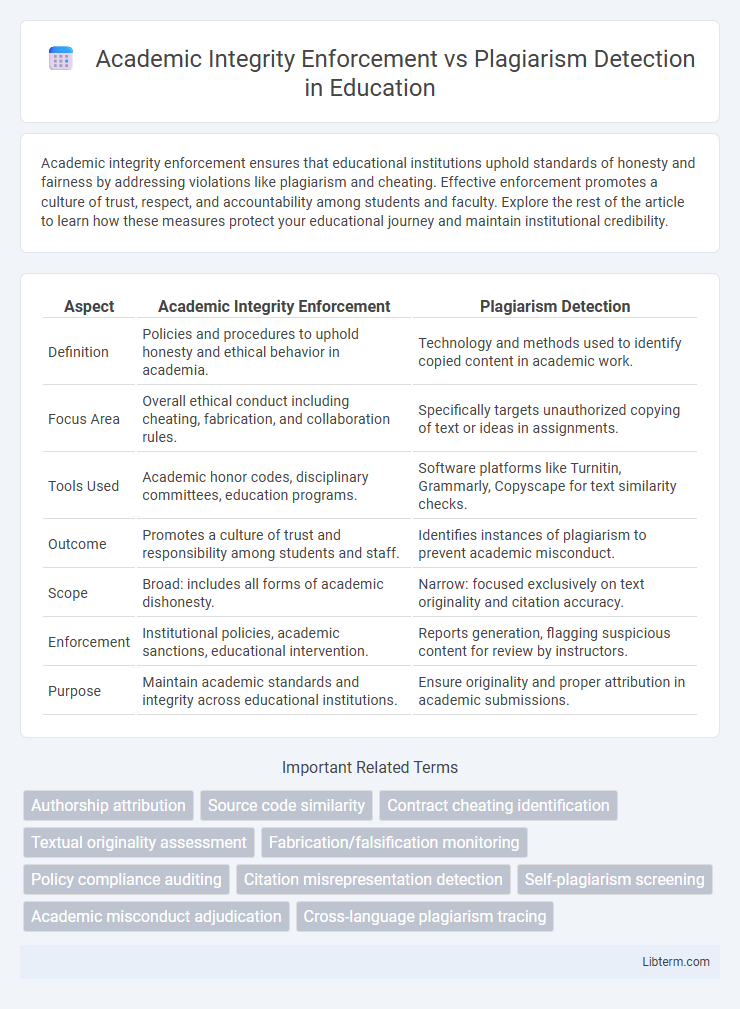Academic integrity enforcement ensures that educational institutions uphold standards of honesty and fairness by addressing violations like plagiarism and cheating. Effective enforcement promotes a culture of trust, respect, and accountability among students and faculty. Explore the rest of the article to learn how these measures protect your educational journey and maintain institutional credibility.
Table of Comparison
| Aspect | Academic Integrity Enforcement | Plagiarism Detection |
|---|---|---|
| Definition | Policies and procedures to uphold honesty and ethical behavior in academia. | Technology and methods used to identify copied content in academic work. |
| Focus Area | Overall ethical conduct including cheating, fabrication, and collaboration rules. | Specifically targets unauthorized copying of text or ideas in assignments. |
| Tools Used | Academic honor codes, disciplinary committees, education programs. | Software platforms like Turnitin, Grammarly, Copyscape for text similarity checks. |
| Outcome | Promotes a culture of trust and responsibility among students and staff. | Identifies instances of plagiarism to prevent academic misconduct. |
| Scope | Broad: includes all forms of academic dishonesty. | Narrow: focused exclusively on text originality and citation accuracy. |
| Enforcement | Institutional policies, academic sanctions, educational intervention. | Reports generation, flagging suspicious content for review by instructors. |
| Purpose | Maintain academic standards and integrity across educational institutions. | Ensure originality and proper attribution in academic submissions. |
Defining Academic Integrity Enforcement
Academic Integrity Enforcement involves implementing policies and procedures to uphold ethical standards in educational institutions, ensuring students submit original work and maintain honesty. It encompasses investigation, adjudication, and sanctions for violations such as cheating, fabrication, and plagiarism. This enforcement fosters a culture of honesty and accountability, which is essential for preserving the credibility of academic credentials.
Understanding Plagiarism Detection Systems
Plagiarism detection systems utilize advanced algorithms and extensive databases to identify unoriginal content by comparing submitted texts against existing sources, ensuring academic integrity. These systems analyze text similarity, citation accuracy, and potential paraphrasing to flag instances of plagiarism effectively. Understanding their technological capabilities and limitations is crucial for educators to enforce academic honesty while fostering genuine learning.
Key Differences Between Enforcement and Detection
Academic integrity enforcement involves implementing policies and disciplinary actions to uphold ethical standards in education, while plagiarism detection focuses on identifying instances of copied or unoriginal content using specialized software. Enforcement requires a systematic approach including investigation, education, and sanctioning, whereas detection primarily relies on technology such as Turnitin or Grammarly to flag potential academic misconduct. The key difference lies in enforcement being a broader, institutional responsibility encompassing prevention and penalties, while detection serves as a technical tool to support that process by uncovering evidence of plagiarism.
The Role of Technology in Plagiarism Detection
Technology plays a critical role in plagiarism detection by utilizing advanced algorithms and machine learning to scan vast databases of academic papers, websites, and other digital content for similarities. Sophisticated software like Turnitin and Grammarly not only identifies copied text but also highlights improper citations, enabling educators to uphold academic integrity more effectively. These tools enhance the enforcement of academic integrity policies by providing objective, consistent, and efficient means to detect and address plagiarism cases.
Human Oversight in Academic Integrity Enforcement
Human oversight plays a crucial role in academic integrity enforcement by ensuring contextual understanding and fair evaluation beyond automated plagiarism detection tools. While plagiarism detection software highlights potential issues, human reviewers assess intent, originality, and academic standards to differentiate between acceptable paraphrasing and unethical copying. This combined approach enhances accuracy in maintaining academic standards and promotes ethical scholarship.
Ethical Considerations in Both Approaches
Academic integrity enforcement emphasizes fostering a culture of honesty and responsibility, prioritizing ethical values such as fairness and transparency in evaluating student work. Plagiarism detection relies on technology to identify copied content, raising concerns about privacy, false accusations, and the importance of contextual judgment. Balancing proactive education on ethics with accurate, respectful application of detection tools ensures a holistic approach to maintaining academic standards.
Limitations of Plagiarism Detection Tools
Plagiarism detection tools often struggle to identify sophisticated paraphrasing, translated content, and idea plagiarism, limiting their effectiveness in enforcing academic integrity. These tools primarily focus on text matching and fail to assess the context, intent, or originality of the work, resulting in false positives or undetected cases. Relying solely on plagiarism detection software overlooks the broader enforcement of academic integrity, which includes ethical education and comprehensive evaluation.
Preventative Strategies for Academic Integrity
Preventative strategies for academic integrity emphasize fostering a culture of honesty through comprehensive education on citation practices and the importance of original work, reducing the reliance on merely detecting plagiarism after submission. Academic institutions implement proactive measures such as honor codes, transparent assessment criteria, and real-time feedback tools to encourage ethical scholarship. These approaches complement plagiarism detection technologies by addressing the root causes of academic misconduct, promoting long-term adherence to integrity standards.
Balancing Punitive and Preventive Measures
Academic integrity enforcement involves implementing clear policies and consequences to deter dishonest behavior, while plagiarism detection tools identify instances of copied or unoriginal work. Balancing punitive measures, such as academic sanctions, with preventive strategies like educating students about citation practices enhances fairness and promotes a culture of honesty. Effective enforcement combines technology and pedagogy to reduce violations and support ethical scholarship.
Future Trends in Academic Integrity Enforcement and Detection
Future trends in academic integrity enforcement emphasize advanced AI-driven plagiarism detection systems capable of analyzing complex writing patterns and semantic similarities beyond exact text matches. Institutions are increasingly adopting blockchain technology for secure and transparent academic record keeping, ensuring authenticity and traceability of student submissions. Integration of real-time monitoring tools and adaptive learning algorithms aims to proactively deter academic dishonesty while promoting a culture of integrity in education.
Academic Integrity Enforcement Infographic

 libterm.com
libterm.com